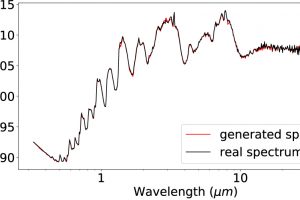Artificial Intelligence applied to astrophysics. The paper “ExoGAN: Retrieving Exoplanetary Atmospheres Using Deep Convolutional Generative Adversarial Networks” of T. Zingales (UCL, INAF – OAPA) published on AJ

In the last few years, many space missions and ground-based surveys, discovered more than 4000 exoplanets, especially using the transit and radial velocity methods. These two methods combined, give us a first estimation of the bulk density of the planets. In order to have a deeper understanding on the planetary characteristics and history, we also need to study their atmospheres. With the current technology (i.e. the WFC3 Hubble camera), it is possible to characterize the atmosphere of transiting planets. During planetary transits, in fact, part of stellar radiation is filtered by the exoplanetary atmosphere. By observing a planetary transit at different wavelengths, it is possible to infer the chemical composition and the physical properties of a planetary atmosphere.
Spectroscopic observations, thus, allow us in principle to study the chemical composition and stratification of exoplanets atmosphere, and in future also to detect the presence of chemical elements indicating the presence of life in the planets. This will be one of the scientific tasks of JWST, the new NASA observatory that will be launched in the next future, and the main task of ARIEL, the mission dedicated to the study of exoplanetary atmospheres which has a great contribution of the Italian scientific community.
However, the study of the chemical composition and properties of the atmospheres of exoplanets from the analysis of spectra is an ill-posed problem. Planetary atmospheres are, in fact, very complicated physical systems which need models with a large number of degree of freedom, that we are trying to reproduce from the few information contained in stellar spectra. Besides, the number of required steps to allow the models to converge is very high (typically 105, 106 iterations), resulting in very high computation times.
A possible solution to this problem is the use of Artificial Intelligence algorithms, i.e. the use of statistical methods which allow the computation algorithms to learn from data sets and make predictions. In particular, to this aim is promising the use of the artificial neural networks, which are algorithms which try to mimic biological neural networks, where the computer tries to learn directly from the dataset, generalising the information and using it to solve very complex problems. In the paper: “ExoGAN: Retrieving Exoplanetary Atmospheres Using Deep Convolutional Generative Adversarial Networks“, recently published by the Astronomical Journal, of Tiziano Zingales (Ph.D. student of the University College of London and INAF – Astronomical Observatory of Palermo, currently post-doc at the Laboratoire d’Astrophysique de Bordeaux) is presented the recently developed algorithm ExoGAN (Exoplanet Generative Adversarial Network), which allows the identification of molecules in the exoplanetary atmospheres, the estimatation of their abundance, and to obtain the physical parameters of the atmosphere from the analysis of exoplanetary spectra. ExoGAN (Exoplanets Generative Adversarial Network), is a Deep Convolutional Generative Advesarial Network, an extremely elastic and versatile deep learning algorithm, that can be applied to a wide range of instruments and exoplanetary types.
The figure (link) compares the simulated spectrum and the one reproduced by ExoGAN of a water-dominated planet.
of Mario Giuseppe Guarcello ( follow mguarce)
